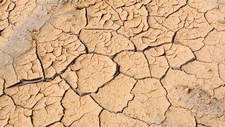Water in Soils
Supporting

TEKS Objective
Examine properties of soils, including color and texture, capacity to retain water, and ability to support the growth of plants.
Essential Understanding
The students know that Earth consists of useful resources and its surface is constantly changing.
Science Background
Dig It! The Secrets of Soil: Smithsonian National Museum of Natural History (website) - Interactives, videos, and activities created for a special Smithsonian exhibit cover a variety of soil-related topics.
Dig It! The Secrets of Soil
Smithsonian National Museum of Natural History, www.si.edu
Soil Texture: Monterrey Institute for Science and Technology (video) – Capacity to retain water is determined by soil texture, as explained in this video.
Soil Texture
Monterrey Institute for Science and Technology, www.hippocampus.org
Signature Lesson
Water Retention: Worcester Polytechnic Institute (PDF) - Students examine and investigate the properties of various soil types, make predictions about the capacities of different soil and sand mixes to retain water, and design an experiment to test their predictions.
Water Retention
Worcester Polytechnic Institute, www.wpi.edu
- Supporting Lessons
- Extensions
- Assessment Ideas
- Literature Connections
- Related
TEKS - Additional Resources
Supporting Lessons
Soil Texture Analysis: Soil Science Society of America (website) - A simple technique for estimating the percentage of sand silt and clay in a soil, and also to determine its texture.
Soil Texture Analysis
by Ted Sammis, Soil Science Society of America, www.soils.org
Perkin' Through the Pores: Utah Agriculture in the Classroom (PDF) – Examine two different soil samples and compare their capacities to retain water.
Perkin' Through the Pores
Utah Agriculture in the Classroom, utah.agclassroom.org
Elaboration Lessons and Extensions
Soiled Again: University of Illinois (website) - Information for young students about soil components, types, nutrients, uses, etc.
Soiled Again
Urban Programs Resource Center, University of Illinois, urbanext.illinois.edu
Dig It! The Secrets of Soil: National Association of Conservation Districts (PDF) - A wide variety of engaging lessons on properties of soils.
Dig It! The Secrets of Soil
National Association of Conservation Districts, www.nacdnet.org
Assessment Ideas
Create different soil samples for each student group by mixing varying amounts of soil and sand. Have students compare the samples and classify them based on the concentration of sand, silt, and/or clay.
Literature Connections
Dirt: The Scoop on Soil. Rosinsky, Natalie M. (ISBN-13: 978-1404803312)
Caves and Caverns. Gibbons, Gail (ISBN-10: 0152013652)
Dirt: Jump Into Science. Steve Tomecek (ISBN-13: 978-0792282044)
Clay. Firestone, Mary (ISBN: 0-064-45078-3)
A Handful of Dirt. Bial, Raymond (ISBN: 0-802-78698-7)
Soil. Richardson, Adele (ISBN: 0-736-80954-6)
Soil. Flanagan, Alice (ISBN: 0-756-50035-4)
Additional Resources
Soils for Grades K-6: US Natural Resources Conservation Service (website) – Links to songs, activities, stories and other teaching resources on soils.
Soils for Grades K-6
US Natural Resources Conservation Service, nrcs.usd.gov
Earth’s Solid Membrane, Soil: Annenberg Learner (website) – Complete this free online course, which covers the basics of soil and includes an engaging one-hour video.
Earth’s Solid Membrane, Soil
Annenberg Learner, www.learner.org
Young Scientists’ Soil Glossary: Soil Science Society of American (Website) – Comprehensive glossary of soil-related words, such as “sediment” and “loam.”
Young Scientists’ Soil Glossary
Soil Science Society of American, www.soils.org
TEKS Navigation
Grade 4
Need Assistance?
If you need help or have a question please use the links below to help resolve your problem.

Comments